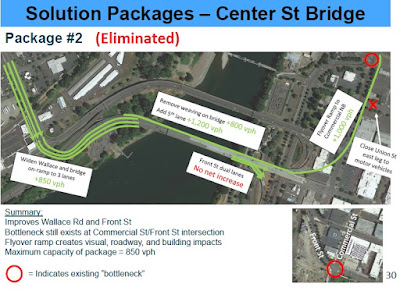Relief as Political Band-aid
Not arising from Coordinated Analysis of the Underlying Problems
 |
| Hydraulic Autoism: We treat traffic like fluid and streets like tubes (from the presentation to the Task Force) |
And anyway, if we are going to look at space and volume only, there are other "capacity relationship concepts" we should also see. It's people/hour, not vehicles/hour that matter! (In the clips below from diagrams presented to the Task Force, note all the +vph and -vph.)
 |
| Vancouver, BC: Drive-alone trips are inefficient |
 |
| Underpriced parking directly invites more traffic: Downtown Surface Parking Lots in Red Parking Garages in Solid Brick Red On-street parking stalls not included |
 |
| Just right-priced parking could reduce trips by 10% TSM/TDM (Transit and Roadway Efficiency) Concept Analysis and Results, 2007 |
Altogether proposals to increase capacity for drive-alone trips is responsive to immediate complaints about congestion, but treats symptoms shallowly, and does not work at the underlying causes and bigger structural problems.
The Proposals
So about the proposals themselves. First we should look at ways they will disadvantage trips that are not drive-alone.
Expanding Capacity for Drive-alone Trips Harms Walking and Biking
Two of the proposals involve widening the bridges.
 |
| Add a lane to the Marion St Bridge |
 |
| More on Adding the Lane |
 |
| Adding a lane to the Center St Bridge |
 |
| Adding an offramp to Marine Drive |
 |
| Requiring Edgewater/Wallace traffic to take Union St |
Rather than making it easier for people to choose not to drive, the proposals will make it more difficult to walk or bike.
The Bundles: Two too Expensive, Five Merit Closer Look
There were several more projects called out in the presentation, but it does not seem necessary to comment on them individually.
They were bundled into seven "Solution Packages" for the Task Force to consider. The two most expensive of the bundles were eliminated.
 |
| Eliminated |
 |
| Eliminated |
So that left five for further consideration and analysis.
 |
| Solution Package #1 for Center St Bridge |
 |
| Solution Package #3 for Center St Bridge |
 |
| Solution Package #1 for Marion St Bridge |
 |
| Solution Package #2 for Marion St Bridge |
 |
| Solution Package #4 for Marion St Bridge |
Some concepts were reserved for later consideration. One of them seemed to involve more traffic on the Union Street Family-friendly Greenway. It's interesting that as part of the lane addition concepts, no Bus-Only configuration seemed to be in the mix.
 |
| Postponed for later analysis |
 |
| Discarded concepts |
Until we are able to get outside of our paradigm of hydraulic autoism, we are going to keep cycling through the same kinds of expensive solutions that failed us in the past. We will keep doing the same things over and over. The "solution packages" we see today, aren't very different from those proposed and constructed in 1980. Maybe we're just looking at things the wrong way.
 |
| 1980 FEIS on widening the bridges |



4 comments:
(Edit: Misremembered date of last meeting; corrected it.)
Dedicated lanes for buses on both bridges.
You make great points about the multimodal analysis that appears to be missing from this process, but the more important point is that Salem River Crossing will do far more to reduce congestion on the bridges (as well as alleviate motor vehicle traffic in central Salem in general) than any of their auto-oriented alternatives. According to the LEHD project of the US census, at least 60% of the ~102k jobs in Salem east of the River are coming from east of the river. Another 6520 are commuting from West Salem. It seems likely that the majority of the ~46k crossings are coming from other parts of Polk County and are going to someplace besides central Salem. Therefore the Salem River Crossing will significantly reduce traffic on Marion & Center. There is no doubt that any congestion that remains could be reduced by increasing transit frequency and bike/walk connections, since most of West Salem is within an easy bus or bike ride from central Salem. If they aren't considering the impact of the Salem River Crossing on this project, then they aren't doing a real world analysis.
Your comment is unclear in important ways. This project arises out of the Salem River Crossing and is a near-term substitute, and is not at all failing to "consider the impact of the Salem River Crossing." You say "most of West Salem is within an easy bus or bike ride from central Salem" and this is not a statement many in West Salem or any Salemite would agree with - are you even from here? Perhaps this misunderstands something in your comment, but it doesn't seem to add up quite right.
Additionally, if you accept the traffic modeling (though we critique it here), under the SRC's own analysis the SRC fails to resolve congestion. It is an article of faith that the SRC will solve congestion, but the SRC's own analysis says no such thing.
For more on that see "The Preferred Alternative is an Expensive Damp Squib" (2016) and "West Salem Neighborhood to talk SRC and Second Street Crossing on Monday" (May of this year).
Generally we should be talking more about demand-side solutions rather than supply-side (new road capacity). See "Let's Talk Demand Rather than Supply."
Thanks for reading!
Post a Comment